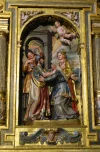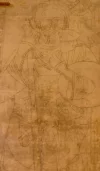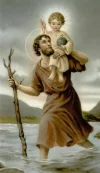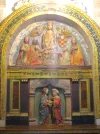-
 ⚠️ Emergency contact in Spain - Dial 112 and AlertCops app. More on this here.
⚠️ Emergency contact in Spain - Dial 112 and AlertCops app. More on this here. -
Remove ads on the forum by becoming a donating member. More here. -
Get your Camino Frances Guidebook here.
Search 74,075 Camino Questions
You are using an out of date browser. It may not display this or other websites correctly.
You should upgrade or use an alternative browser.
You should upgrade or use an alternative browser.
Burgos Cathedral
- Thread starter Bert45
- Start date
Perfect memento/gift in a presentation box. Engraving available, 25 character max.
DreamWeaver
Active Member
- Time of past OR future Camino
- (2018)
St Joachim and St Anne, parents of Virgin Mary. They were childless for many years. The day angel informed him that his wife was conceived, he rushed home, met his wife at the city gate of Jerusalem.
J Walking
Member
- Time of past OR future Camino
- 2022 C.F from SJPP / 2023 C.P. from Porto
I cherish the memory of visiting Burgos and the magnificent gothic Cathedral when I walked the Camino from SJPP to SdeC in 2022.
The entire side chapel in the Burgos Cathedral is dedicated to the life of the Virgin Mary including scenes of the visit of Michael the Archangel (the Annunciation), Mary’s visit to her cousin, Elizabeth (the Visitation), the arrival of the Three Wise Men to honor the infant Jesus, and other significant events in the life of Mary.
The scene you photographed is the nativity of Mary herself. The Catholic Church dogma is that she herself was born without sin (the Immaculate Conception) and therefore the holy Mother of Jesus.
I believe that the two predominant figures in the tableau are Mary’s parents: Saint Joachim and Saint Anne. Cherub (plural cherubim) are present to demonstrate that the event was divine.
The entire side chapel in the Burgos Cathedral is dedicated to the life of the Virgin Mary including scenes of the visit of Michael the Archangel (the Annunciation), Mary’s visit to her cousin, Elizabeth (the Visitation), the arrival of the Three Wise Men to honor the infant Jesus, and other significant events in the life of Mary.
The scene you photographed is the nativity of Mary herself. The Catholic Church dogma is that she herself was born without sin (the Immaculate Conception) and therefore the holy Mother of Jesus.
I believe that the two predominant figures in the tableau are Mary’s parents: Saint Joachim and Saint Anne. Cherub (plural cherubim) are present to demonstrate that the event was divine.
A selection of Camino Jewellery
- Time of past OR future Camino
- Us:Camino Frances, 2015 Me:Catalan/Aragonese, 2019
Thanks, Dreamweaver and J Walking. I'm sure that a lot of people think that the Immaculate Conception refers to the conception of Jesus. I have some difficulty figuring out how Joachim and Anne managed to do the deed without sin, but ours not to reason why etc.
- Time of past OR future Camino
- some and then more. see my signature.
Please allow me to piggyback on this post; I have a Burgos cathedral question too. It's very broad; tell me about this large drawing on the wall, especially why it hasn't been painted in. It is near where you pick up the headsets.
View attachment 179062

Iconographie de saint Christophe : la cathédrale de Burgos. - Le blog de jean-yves cordier
Iconographie de saint Christophe : la cathédrale de Burgos. Voir : Petite iconographie de Saint Christophe à Séville, III. Le vitrail d'Arnaud de Flandres fils de la cathédrale (1546). Baie 55. Petite iconographie de Saint Christophe à Séville. II :...
 www.lavieb-aile.com
www.lavieb-aile.com
The one from Galicia (the round) and the one from Castilla & Leon. Individually numbered and made by the same people that make the ones you see on your walk.
Oooh! I have a photo of that too! And no idea what it represents, unless it could be St Christopher (a guess), as I've seen paintings of St Christopher like that in other churches and cathedrals in what I think is the same area of the building, the south transept.. I came across my photo (taken in 2016) earlier today. I hope you are lucky with your piggy-back – I don't mind at all – but I think you'd have better luck with a separate post.Please allow me to piggyback on this thread; I have a Burgos cathedral question too. It's very broad; tell me about this large drawing on the wall, especially why it hasn't been painted in. It is near where you pick up the headsets.
View attachment 179062
- Time of past OR future Camino
- Us:Camino Frances, 2015 Me:Catalan/Aragonese, 2019
Train for your next Camino on California's Santa Catalina Island March 16-19
- Time of past OR future Camino
- Us:Camino Frances, 2015 Me:Catalan/Aragonese, 2019
That seems to be the case. The document that @SabsP directed me to mentioned that the top of the drawing (but it had been painted in) had been erased. A clearer detail there shows a headless Christ child.The foot is most likely the foot of the baby Jesus that Saint Christopher is often seen carrying on his shoulders.
Jodean
Veteran Member
- Time of past OR future Camino
- 2015CF, 2018CP, 2018CF,
2022CF, 2023CF, 2024CP
I have understood it that Mary was born of immaculate conception to Anne and Joachim. So, she is super pure.
The wiki article goes into more depth: https://en.wikipedia.org/wiki/Immaculate_Conception
I do tours where Anne is featured in wall paintings and altars, and the majority of people have never heard of her, yet there are altars all over Europe to her. When did she become forgotten, as well as Joachim.
The wiki article goes into more depth: https://en.wikipedia.org/wiki/Immaculate_Conception
I do tours where Anne is featured in wall paintings and altars, and the majority of people have never heard of her, yet there are altars all over Europe to her. When did she become forgotten, as well as Joachim.
bullingtonce
Active Member
- Time of past OR future Camino
- I plan to do the Ruta de la Lana in August/September 2021
Don't know about the other figures in this painting, but the figure on the far left in a spiritual spasmodic fit, unable to come to grips with being and maintaining the appropriate spiritual state, represents how I have been most of my life. However and for some reason God still puts up with me and even cares for me (go figure) so I've been able to survive. Chuck PS No concern or sympathy needed for as soon as can find the spiritual equivalent of the 911 emergency line I will make the call. I know God has one but the Yellow Pages have absolutely of no benefit. ChuckCan anybody tell me what the section of the retablo of the Chapel of the Birth Of the Virgin Mary (Capilla de la Natividad de la Virgen) represents, shown in the attached photo? Thanks.View attachment 179046
Perfect memento/gift in a presentation box. Engraving available, 25 character max.
Pafayac
On the way...
- Time of past OR future Camino
- Plata ? Portugues ? Invierno ?
Immaculate Conception (of Mary Mother of God), according to catholic theology, means that she had escaped from the "original sin".I have some difficulty figuring out how Joachim and Anne managed to do the deed without sin, but ours not to reason why etc.
When married people conceive a child, they do not do a sin, at least according to my understanding of what a sin is.
- Time of past OR future Camino
- To Santiago and back. Le Puy to Aumont-Aubrac.
Immaculate Conception and original sin versus personal sin ... not easy concepts.The wiki article goes into more depth: https://en.wikipedia.org/wiki/Immaculate_Conception
I do tours where Anne is featured in wall paintings and altars, and the majority of people have never heard of her, yet there are altars all over Europe to her. When did she become forgotten, as well as Joachim.
Thanks for the link. I noticed this line: "In the 16th and especially the 17th centuries there was a proliferation of Immaculatist devotion in Spain, leading the Habsburg monarchs to demand that the papacy elevate the belief to the status of dogma."
I remember having read - don't ask me where - that there was quite a fight within the Catholic Church about this concept in Spain to the extent that at one time even children were singing - or were made to sing - in the streets of Seville "Inmaculada Concepción, Inmaculada Concepción" until the dispute finally ended and it was declared a dogma by the Pope.
Apparently, Seville has a tradition where choirboys perform a dance in the cathedral on the 8th of December (as well as on two other days of the liturgical year). I wonder whether it's related. It is called Baile de los Seises and it is on YouTube of course.
The day is a public holiday in Spain, Portugal, Malta, Italy and Austria.
- Time of past OR future Camino
- To Santiago and back. Le Puy to Aumont-Aubrac.
The man carries a sheep. That's why his arms are in the position they are in. The gate is called "Sheep Gate". It is where sheep were brought to the Temple for sacrifice. The Sheep Gate is part of a traditional narrative of Joachim and Anne.the figure on the far left in a spiritual spasmodic fit, unable to come to grips with being and maintaining the appropriate spiritual state
There is often meaning in additional figures, animals and other items in religious paintings.
Train for your next Camino on California's Santa Catalina Island March 16-19
- Time of past OR future Camino
- 2012, 2015, 2018, 2019, 2022, 2024
Oh! I see it (the sheep) now. Thanks, Kathar1na.The man carries a sheep. That's why his arms are in the position they are in. The gate is called "Sheep Gate". It is where sheep were brought to the Temple for sacrifice. The Sheep Gate is part of a traditional narrative of Joachim and Anne.
There is often meaning in additional figures, animals and other items in religious paintings.
I'm pretty sure it's labelled somewhere in the church as being The Visitation of Mary to Elizabeth, the soon-to-be mother of John the Baptist. The scroll above them says: "Et unde hoc mihi ut veniat mater Domini mei ad me?" [And why is this happening to me, that the mother of my Lord should come to me?] Luke 1:43.I´ve always wondered about the lower panel in this tableau, in the church of Sau Bento, Santiago. Ss Anne and Joachim make sense as they are the parents of Mary who is depicted in the Nativity above. I don´t know the date but it looks early Gothic.
View attachment 179092
Ideal sleeping bag liner whether we want to add a thermal plus to our bag, or if we want to use it alone to sleep in shelters or hostels. Thanks to its mummy shape, it adapts perfectly to our body.
€46,-
€46,-
DreamWeaver
Active Member
- Time of past OR future Camino
- (2018)
maybe because Anne and Joachim were not mentioned in the bible, it was a story in the Gospel of St James.I do tours where Anne is featured in wall paintings and altars, and the majority of people have never heard of her, yet there are altars all over Europe to her. When did she become forgotten, as well as Joachim.
DreamWeaver
Active Member
- Time of past OR future Camino
- (2018)
me tooI have some difficulty figuring out how Joachim and Anne managed to do the deed without sin
- Time of past OR future Camino
- To Santiago and back. Le Puy to Aumont-Aubrac.
Mary visiting Elizabeth, both being pregnant, is also depicted on the beautifully crafted Romanesque lid of the sarcophagus of Queen Blanca that you had asked about in an earlier thread.The Visitation of Mary to Elizabeth, the soon-to-be mother of John the Baptist
This young queen had died due to complications after the birth of her child or during the subsequent pregnancy. Dying of such complications was a lot more common in the Europe of the Middle Ages than it is now. Themes on the lid revolve around duties in the life of a Christian woman at the time.
The door to the right of Christ is open while the door to his left is locked. The four women nearest to the open door and the five women nearest to the closed door have an identical position. Each one of them holds the same small object. The two women on the far end have a different position and face each other. They are Mary and Elizabeth, and the others represent the Parable of the Ten Virgins with the tenth woman missing because the lid is damaged and part of it had been chopped off to make it fit when it was moved at one time to a different location in the Najéra Pantheon.
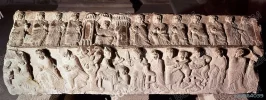
Last edited:
Get a spanish phone number with Airalo. eSim, so no physical SIM card. Easy to use app to add more funds if needed.
Thanks again. Kathar1na. That explains a lot! Your eye for detail beats mine by a country mile. I didn't notice that one door was open and the other closed, and I didn't notice that the two figures on the right were different from the others. Your post answers the question I asked on 18 September (The Princes' Pantheon). But why do you say that each of the women holds "the same small object"? You say that they represent the parable of the Ten Virgins, which is also stated in the information near the sarcophagus. So the small objects they are holding must be lamps.
I can only suppose that the carver found he had some space left over on the right-hand side when he had finished carving the ten virgins, and decided to fill it with Mary and Elizabeth. The information given by the sarcophagus says: "The back side presents biblical scenes related to nuptials or maternity, in which women play an essential role. In the centre, we can see Christ in Majesty surrounded by girls who carry lamps." What do ten virgins with lamps have to do with nuptials or maternity? Your analysis gives more information than that given by the monastery.
I can only suppose that the carver found he had some space left over on the right-hand side when he had finished carving the ten virgins, and decided to fill it with Mary and Elizabeth. The information given by the sarcophagus says: "The back side presents biblical scenes related to nuptials or maternity, in which women play an essential role. In the centre, we can see Christ in Majesty surrounded by girls who carry lamps." What do ten virgins with lamps have to do with nuptials or maternity? Your analysis gives more information than that given by the monastery.
- Time of past OR future Camino
- Us:Camino Frances, 2015 Me:Catalan/Aragonese, 2019
The information given by the sarcophagus says: "The back side presents biblical scenes related to nuptials or maternity, in which women play an essential role. In the centre, we can see Christ in Majesty surrounded by girls who carry lamps." What do ten virgins with lamps have to do with nuptials or maternity?

Parable of the Ten Virgins - Wikipedia
- Time of past OR future Camino
- To Santiago and back. Le Puy to Aumont-Aubrac.
Thanks for the link to the Wikipedia article where one cannot only read the parable but also some of the interpretations of this biblical story. Like many in my generation I am familiar with a lot of the content of these narratives that were major motifs in medieval religious art but I usually have to read up on them to refresh my memory. Always useful to do before posting.
Biblical scenes in which women, women and their children, or their children play an essential role and where the focus is not on men and their role - that is what the scenes on this part of the lid of the sarcophagus show: the parable of the ten women; two pregnant women; the adoration of the 3 kings where the mother is more a focal point than the father; the Solomon judgment where the mother prefers to live without her child than have her child cut in half and killed; the mass murder of children.
Maybe I mentioned this already once or twice: I would not treat every word on these info boards as the gospel and take everything literally or even regard it as correct facts according to the state of current knowledge.The information given by the sarcophagus says: "The back side presents biblical scenes related to nuptials or maternity, in which women play an essential role."
Biblical scenes in which women, women and their children, or their children play an essential role and where the focus is not on men and their role - that is what the scenes on this part of the lid of the sarcophagus show: the parable of the ten women; two pregnant women; the adoration of the 3 kings where the mother is more a focal point than the father; the Solomon judgment where the mother prefers to live without her child than have her child cut in half and killed; the mass murder of children.
€2,-/day will present your project to thousands of visitors each day. All interested in the Camino de Santiago.
- Time of past OR future Camino
- To Santiago and back. Le Puy to Aumont-Aubrac.
Funny: I really pays to read first and then post  . I wrote "items" in an earlier post because I can't quite see what it is that they carry. I knew of course that the lamps and the missing oil are an essential part of the narrative.
. I wrote "items" in an earlier post because I can't quite see what it is that they carry. I knew of course that the lamps and the missing oil are an essential part of the narrative.
Now that I've read a version of Matthew 25:1-13, I see that they took oil in their vessels with their lamps; and just to make sure see Luther: sie nahmen Öl in ihren Gefäßen samt ihren Lampen; and in Español: llevaron vasijas de aceite junto con sus lámpares. Maybe they are holding vessels for the oil and not lamps.
PS: Look what they are holding on the portal of the Cathedral of Amiens, a masterpiece of Gothic religious art and architecture. Same biblical parable, same period of time. Context is everything ... And Amiens is on a major road to Spain, these days you can even find a bronze scallop shell as a marker for a chemin de Saint Jacques on the pavement near the Cathedral - maybe the idea for this motif travelled along this road.
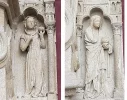
Now that I've read a version of Matthew 25:1-13, I see that they took oil in their vessels with their lamps; and just to make sure see Luther: sie nahmen Öl in ihren Gefäßen samt ihren Lampen; and in Español: llevaron vasijas de aceite junto con sus lámpares. Maybe they are holding vessels for the oil and not lamps.
PS: Look what they are holding on the portal of the Cathedral of Amiens, a masterpiece of Gothic religious art and architecture. Same biblical parable, same period of time. Context is everything ... And Amiens is on a major road to Spain, these days you can even find a bronze scallop shell as a marker for a chemin de Saint Jacques on the pavement near the Cathedral - maybe the idea for this motif travelled along this road.

Last edited:
The first edition came out in 2003 and has become the go-to-guide for many pilgrims over the years. It is shipping with a Pilgrim Passport (Credential) from the cathedral in Santiago de Compostela.
- Time of past OR future Camino
- Us:Camino Frances, 2015 Me:Catalan/Aragonese, 2019
I only took a good look at the carving this morning. This is totally unimportant, to me at least, but Mary and Elizabeth are at the side of the carving with the locked door and I think this is strange. Maybe someone didn't think all the symbology through. I also noticed that the women on each of the two sides seemed to be carrying something different and in a different way. It's pretty difficult to see what the object is but the ones on the left by the open door possibly may be portrayed with flames. Besides being by the opened door to salvation the flames would indicate that these women were the saved ones (if their lamps were indeed lit). Again though, this seems to have Mary and Elizabeth on the wrong side of the lid.The door to the right of Christ is open while the door to his left is locked. The four women nearest to the open door and the five women nearest to the closed door have an identical position. Each one of them holds the same small object. The two women on the far end have a different position and face each other. They are Mary and Elizabeth, and the others represent the Parable of the Ten Virgins with the tenth woman missing because the lid is damaged and part of it had been chopped off to make it fit when it was moved at one time to a different location in the Najéra Pantheon.
Yes, I agree with Kathar1na and Rick; it's hard to see what the women are carrying, but it's clear that the women on each side of what? the Kingdom of Heaven? are portrayed in different ways. But who are the careful ones and who are the careless? (I don't expect a definitive answer, or any answer, really.) I would expect the ones on the right to be the careful ones, as they are on the same side as Mary and Elizabeth. So these would be carrying oil. But, if the careless ones are carrying lamps, the careful ones should be carrying oil and lamps.
Can we be sure that the two figures on the far right are Mary and Elizabeth? Can we be sure that they are two women? The figure furthest right looks a bit odd to me, a bit like a man with a beard. We need a really good 'straight-on' photo of that side of the sarcophagus. If they are not Mary and Elizabeth, the argument as to which are the careful virgins goes with them.
I accept, grovellingly, Kathar1na's admonition.
Can we be sure that the two figures on the far right are Mary and Elizabeth? Can we be sure that they are two women? The figure furthest right looks a bit odd to me, a bit like a man with a beard. We need a really good 'straight-on' photo of that side of the sarcophagus. If they are not Mary and Elizabeth, the argument as to which are the careful virgins goes with them.
I accept, grovellingly, Kathar1na's admonition.
Last edited:
€2,-/day will present your project to thousands of visitors each day. All interested in the Camino de Santiago.
- Time of past OR future Camino
- To Santiago and back. Le Puy to Aumont-Aubrac.
On the left side, seen from the pov of the observer, are those who are prepared for the Day of Jugdment, and seen from the pov of Christ, they are on his right side. The door is open for those who are prepared and the door is closed for those who are unprepared or ill prepared. The parable is understood as a narrative about the Day of Judgment which was believed to be imminent and that's why it is often illustrated in medieval religious art; it was also one of the driving forces for medieval pilgrimages and for medieval charity.it's hard to see what the women are carrying, but it's clear that the women on each side of what? the Kingdom of Heaven? are portrayed in different ways. But who are the careful ones and who are the careless? (I don't expect a definitive answer, or any answer, really.) I would expect the ones on the right to be the careful ones
The good ones to the right of Christ and the bad ones to the left of Christ - you've seen this arrangement many times along the Camino Francés, for example on the tympanum of Leon Cathedral or on the tympanum of the church just before Estella - one of my favourites.
The upper row on the lid of the sarcophagus contains two separate scenes of two separate narratives. No doubt the Royal House of Navarra contracted a highly skilled sculptor, perhaps a foreign craftsman and artist who had been working on one of the nearby building sites for a new church or a new cathedral. I doubt that they chose a worker from the next village who started sculpting the parable and then suddenly thought, oh yikes there is some space left in this row, let's put two more women on there. These medieval religious sculptures contain a program; they were carefully planned.
Typical medieval Last Judgment scene - "good ones" on the right side of Christ - Leon Cathedral
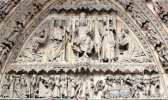
Last edited:
- Time of past OR future Camino
- To Santiago and back. Le Puy to Aumont-Aubrac.
The Cathedral of Burgos has a portal and tympanum with the same motif. I did not see it because there is so much to see in this cathedral. But we have the internet to catch up on what we missed:
On the left [= right side of Christ] are the blessed ones. They are greeted by an angel and an open door leading to Glory. The less fortunate ones are on the right [= left side of Christ]. They are condemned to go to Hell. In the middle is Saint Michael with a balance to weigh the souls.
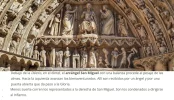
On the left [= right side of Christ] are the blessed ones. They are greeted by an angel and an open door leading to Glory. The less fortunate ones are on the right [= left side of Christ]. They are condemned to go to Hell. In the middle is Saint Michael with a balance to weigh the souls.

Last edited:
❓How to ask a question
How to post a new question on the Camino Forum.
Most read last week in this forum
I have done 7 walks including three CF, and I had been fortunate that I had not been affected by bedbugs. Now I have my next CF walk scheduled in next April and have heard two of my friends got...
Asking for friends planning to walk the Frances from SJPP tp SdeC in 2025. What were folks who have walked during summer/fall 2024 been spending per day? They are a couple preferring a private...
- Locked
Hello everyone, I hope you are well!
I did the Camino Ingles last year and it was an amazing spiritual experience.
This year, with many personal changes coming up, i feel the need to walk for a...
I'm currently staying near Oviedo, in the north of Spain. I know there are various Camino trails near here but I can't find any using Google maps and Google searching. Is it possible to find...
Hello, has anyone been to the Sahagun street market. Do you know if they close promptly at 2:00pm (I'll be walking there on a Saturday). What kind of stands/boothes are there (food, cheese...
Reading
https://www.caminodesantiago.me/community/threads/ruins-of-a-tower-between-hontanas-and-castrojeriz.89457/
reminded me of a tower near Azqueta.
I don't think I was on this forum back...
Similar threads
❓How to ask a question
How to post a new question on the Camino Forum.
Most downloaded Resources
-
“All” Albergues on the Camino Frances in one pdf“All” Albergues on the Camino Frances in one pdf
- ivar
- Updated:
-
A selection of favorite albergues on the Camino FrancésFavorite Albergues along the Camino Frances
- Ton van Tilburg
- Updated:
-
Profile maps of all 34 stages of the Camino FrancesProfile maps of all 34 stages of the Camino Frances
- ivar
- Updated:


